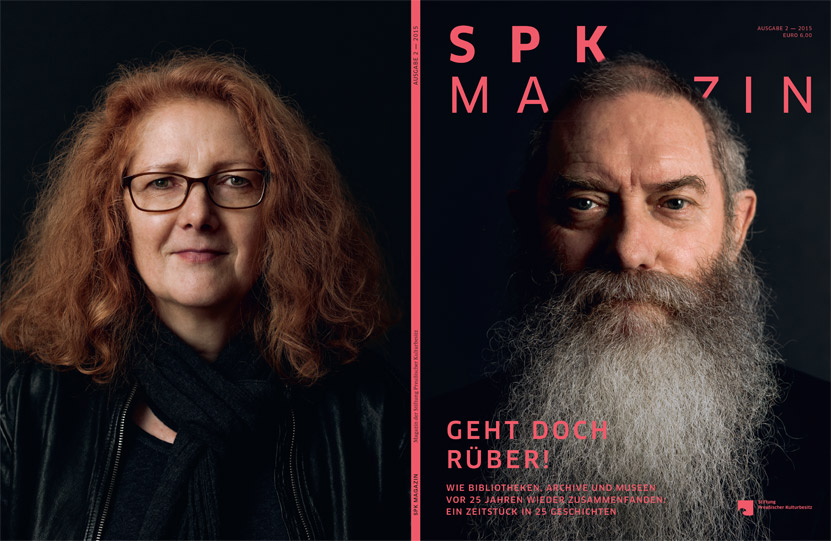Bereichsnavigation
SPK Magazine 2/2015: Go on, Cross the Border!
The new issue of SPK Magazine reports on the reunification of the Berlin collections 25 years ago. It tells the stories of those who were there – people from the East and the West, from restorer to museum director.

The Story of Reunification Told from Multiple Perspectives
"1990 is a landmark year in the history of the former Prussian collections. It marks the consolidation of these collections under the roof of the Stiftung Preussischer Kulturbesitz (Prussian Cultural Heritage Foundation) and ends four and a half decades of division. [...] Difficulty and hardship are inevitable in the wake of such radical upheaval, in particular for our staff from the former GDR. We are doing our best to keep these hardships to an absolute minimum and, in the spirit of partnership, to face difficulties head on and overcome them."
These words were written by the then president of the Stiftung Preussischer Kulturbesitz, Werner Knopp, a quarter of a century ago in his Christmas letter to the Foundation's employees. This letter marked the beginning of efforts to reunite libraries, archives, and museums. It was followed by a period of planning in 1991 and 1992, and the implementation of those plans in subsequent years. After four and a half decades of division, the former Prussian collections lay spread out across the city, having been arbitrarily parceled out between East and West Berlin. But here, too — to paraphrase Willy Brandt, former German chancellor and champion of reunification — what had always belonged together was coming together.“
25 Different People Tell Their Stories
The SPK Magazine is reporting on this process of reunification from a very personal perspective. Twenty-five of the staff working at venues and places as diverse as the Museumsinsel (Museum Island), the Kulturforum, Dahlem, and Köpenick, describe what they experienced during this time. These are stories of upheaval and relocation, of promise and doubt, of great plans and compromises. The faces that go along with this chorus of voices have been captured in powerful portraits by Berlin photographer Werner Amann.
And as they talk and share their memories, the whole breadth of the story of reunification unfolds — a story that has never been told like this before. Warehouses, archives, and exhibition venues were relocated. Objects moved from East to West and vice-versa. Files belonging to the Geheimes Staatsarchiv Preussischer Kulturbesitz (Prussian Secret State Archives) were loaded onto a freight train and brought back from Merseburg. Staff at the Kunstgewerbemuseum (Museum of Decorative Arts) in Köpenick fought for the survival of their palace, while their colleagues at the Gemäldegalerie (Old Master Paintings), hoped to move back to the Museumsinsel. Contact between the East and West had been forbidden for years. On November 9, 1989, the time came for people to go to the other half of their city and to see once again the "missing" half of the divided collections. Soon this romantic phase was to be followed by a realistic one with arguments and fighting. It is plain now that although we have overcome the division during the past 25 years, its consequences can still be seen today in Berlin's museum landscape and in its plans for the future.
Correction
On page 4 of the Table of Contents, Peter Altekrüger is mentioned as being from the West. Instead of "West," it should read "East."
On page 57, it is incorrectly stated that Werner Vogel was made Director of the Geheimes Staatsarchiv PK in October 1990[…] In fact, Werner Vogel was made Director in April 1990.
We apologize for these errors.
The Editors









